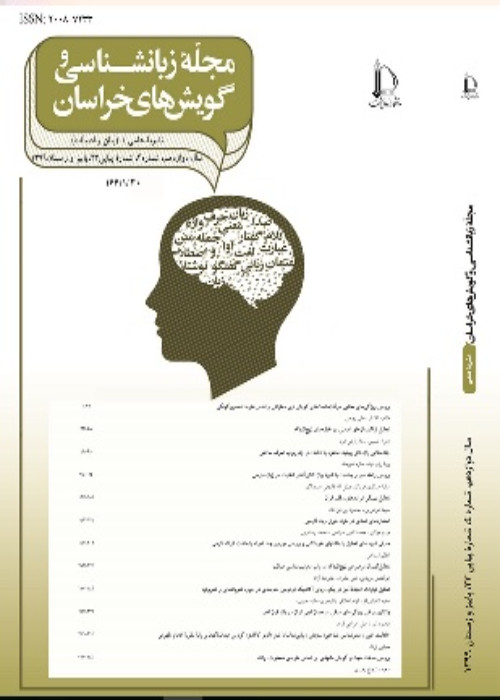Locative Alternations in Placement Verbs and Its Causes: A Functional Analysis
Author(s):
Article Type:
Research/Original Article (دارای رتبه معتبر)
Abstract:
Introduction
Locative alternation is a type of multiple argument realization of three-argument transitive verbs involving variable syntactic expression of the arguments. The present paper is, then, an attempt to find an account for this kind of alternation in Persian placement verb based upon the theory of Role and Reference Grammar (RRG) and tries to introduce an account involving semantic macro roles. Moreover, the roles of primary and secondary objects as well as of incorporation are examined.Locative alternation in Persian as well as in English is realized in two variants: location variant and locatum one. To elaborate more, an example from Persian as well as its parallel structure in English comes below: (1) a.¬Kârgar-h⬬¬ mive¬¬¬ r⬠¬tuye¬ kâmiyun bâr
worker.PL.NOM hay-DO OBJ-marker PREP truck.OBL load.PAST-
zad-and
PL.3SG
'The workers loaded the hay into the truck.'
(DO: theme location variant~ straight construction)
b. ¬Kârgar-hâ kâmiyun r⬠mive¬ ¬ bâr¬ zad¬¬and
Worker .PL.NOM ¬ truck.DO OBJ.marker hay.DO load.PAST-PL.3SG
'The workers loaded the trucks with hay.'
(DO: location locatum variant~ inverted construction
Comparing the Persian example with its English translation suggests that locative alternation in Persian is not usually the same as what we have in English. In English, one of the argument is realized immediately after verb and the other comes as an oblique. In the first sentence, the argument denoting a location is realized as an oblique and the argument denoting a moved entity as the direct object; the syntactic functions of the two arguments are the other way round in another variant: The argument bearing the thematic relation location appears as direct object, the moved entity as an oblique. It is generally assumed that the first construction is "straight" and the second is "inverted" (Kailuweit, 2008).
In Persian, however, the theme is followed by /râ/ in one variant and comes before the verb in the other one while the location is realized as oblique on one variant and followed by / râ/ in the other (Karimi Dustan, & Safari, 2011).
Theoretical Framework: Role and Reference Grammar is a functional theory relying on three underlying representation which provides a typological approach to linguistic description and greatly concerns with the interplay of syntax, semantics, and pragmatics. Following Dowty's representational scheme (1979), state and activity are two main classifications of verb from which the other verb classes are derived. Thus, the state verbs have solely bare predicates in their logical structure while activities, achievements and accomplishments add do', INGR and BECOME, respectively.
Semantic roles are examined in three levels in RRG: Verb-specific semantic roles like runner or speaker, thematic relations as agent or patient, and generalized semantic roles or semantic macro-roles that are actor and undergoer.
Methodology
Some data involving the locative alternation in placement verb are gathered from TV programs, lectures, novels, daily conversations or any other sources providing authentic data in Persian; theses data are, then, analyzed based on RRG theoretical framework. Focusing on the aktionsart the verbal predicates presented, the logical structures of the relevant data are, therefore, provided and undergoers are chosen according to the positions the arguments have in the actor-undergoer hierarchy.Results And Discussion
(1)Locative alternation is regarded as a marked undergoer choice in Role and Reference Grammar in which x in Pred' (x) is the marked choice of undergoer (Van Valin & Lapolla, 1997). Then, the logical structure reveals the location as the undergoer. For instance, the logical structure of the following sentence is α= [do'(kimiâ, ∅)] CAUSE [BECOME (β=be-loc' (divâr,rang))] in which Kimia is the actor and divâr is the undergoer.(2) Kimiâ rang=râ be divâr pâšid-Ø
Kimia.PN paint=OM PREP wall spray.PST-3sg
Kimia sprayed the paint on the wall
Role and Reference Grammar is a functional, context-based theory; therefore, context plays a significant role in the logical structures of the sentences in this grammar. If the theme is a specific and referential argument, its logical structure is like (3) while when it is a non-referential or mass noun, incorporation gets involved and the logical structures turn into (4).
(3) α=[do'(kimiâ,∅)] CAUSE [BECOME (β=be-loc^' (divâr,rang))]
.rang pâšid (kimiyâ, divâr)
In such two-place argument, only one argument can be selected as the undergoer and that is " divâr". The bare noun before verb in inverted construction of locative alternation in Persian is realized in two forms depending on the relevant context. Such noun is either a secondary object and comes in core or it is realized as a non-referential noun in incorporating verb and is regarded as predicate which comes in nucleus layer. The logical structure of the marked/ inverted construction in locative alternation is as (3) with different argument realizations. Such structure has an entailment of holistic interpretation which can be banned depending on encyclopedic knowledge or the context involved. The claim by Kailuweit (2008) can, then, be modified into (3): Semantic effect of marked Undergoer choice: "If an argument is a marked choice for undergoer in a given LS, it is interpreted as a prototypical undergoer' i.e. as having at least one of the properties "causally affected", "change of state", "incremental/ extensional theme". " Kailuweit (2008:350) This can be solely realized if the encyclopedic knowledge or the context in which the sentence is uttered do not ban its realization.
The marked undergoer choice of location in inverted construction of locative alternation may enjoy a holistic interpretation in some particular context as having at least one of the properties "causally affected", "change of state", "incremental/ extensional theme".
Conclusions and Suggestions: Giving some examples of locative alternarion in Persian, the present study concluded that two arguments- theme and location- are competing to receive the macrorole of undergoer. Then, "marked-undergoer- choice-rule" is imposed to choose the location argument as undergoer in the inverted constructions; however, this is not working when incorporation is involved; in that case, there is only one core argument in the construction that is selected as undergoer.
Keywords:
Language:
Persian
Published:
Journal of Linguistics & Khorasan Dialects, Volume:9 Issue: 17, 2018
Pages:
1 to 19
magiran.com/p1846790
دانلود و مطالعه متن این مقاله با یکی از روشهای زیر امکان پذیر است:
اشتراک شخصی
با عضویت و پرداخت آنلاین حق اشتراک یکساله به مبلغ 1,390,000ريال میتوانید 70 عنوان مطلب دانلود کنید!
اشتراک سازمانی
به کتابخانه دانشگاه یا محل کار خود پیشنهاد کنید تا اشتراک سازمانی این پایگاه را برای دسترسی نامحدود همه کاربران به متن مطالب تهیه نمایند!
توجه!
- حق عضویت دریافتی صرف حمایت از نشریات عضو و نگهداری، تکمیل و توسعه مگیران میشود.
- پرداخت حق اشتراک و دانلود مقالات اجازه بازنشر آن در سایر رسانههای چاپی و دیجیتال را به کاربر نمیدهد.
In order to view content subscription is required
Personal subscription
Subscribe magiran.com for 70 € euros via PayPal and download 70 articles during a year.
Organization subscription
Please contact us to subscribe your university or library for unlimited access!



